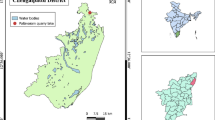Abstract
The effect of formulated aminocarb (Matacil®) an insecticide, on the viability of algal communities in a New Brunswick (Canada) pond was investigated by using the carbon-14 assimilation method. The concentration at which there was a 50% reduction of carbon assimilation (EC50) was 0.98 ppm, calculated on the basis of the aminocarb component. All detectable carbon uptake by the algae had ceased at a concentration of 1.5 ppm aminocarb. Algal production was found to recover within 72 hr from formulated aminocarb application at concentrations up to 2.24 ppm. Recovery was probably due to the existence of algal cells tolerant to this pesticide. Matacil® concentrations have been reported in terms of the aminocarb component and does not imply that aminocarb is in itself causing disruption of algae.
Similar content being viewed by others
References
Anonymous: Fenitrothion: the effects of its use on environmental quality and its chemistry. National Research Council of Canada, Ottawa,14140, (1975).
Butler, G. L., T. R. Deason, and J. C. O'Kelley: Effect of three insecticides and two herbicides on twenty-one freshwater algae. J. Phycol.10, 10 (1974).
Cole, D. R., and F. W. Plapp: Inhibition of growth and photo-synthesis inChorella pyrenoidosa by polychlorinated biphenol and several insecticides. Environ. Entomol.3, 217 (1974).
Cox, J. C.: DDT residues in marine phytoplankton: increase from 1955 to 1969. Science170, 71 (1970).
Eidt, D. C.: The toxicity of aminocarb and fenitrothion to stream insects. In I. W. Varty (ed.): Environmental surveillance in New Brunswick, Canada 1978–1979. Effects of spray operations for forest protection. University of New Brunswick (1979).
Elner, J. K., and D. J. Wildish: Seasonal data on the microbial community of four New Brunswick ponds, including a period of experimental spraying with Matacil®. Can. Tech. Rep. Fish. Aquat. Sci. 993 (1981).
Gillis, G. F.: Assessment of the effects of insecticide contamination in streams on the behaviour and growth of fish. In I. W. Varty (ed.): Environmental surveillance in New Brunswick 1978–1979. Effects of spray operations for forest protection. University of New Brunswick (1979).
Gillott, M. A., G. L. Floyd, and D. V. Ward: The role of sediment as a modifying factor in pesticide-algae interactions. Environ. Entomol.4, 621 (1975).
Kopecek, K., F. Fuller, W. Ratzmann, and W. Simonis: Lichtabhängige Insektizidwirkungen auf einzellige Algen. Ber. Deutsch. Bot. ges. Bd.88, 169 (1975).
McLeese, D. W., V. Zitko, C. D. Metcalfe, and D. B. Sergeant: Lethality of aminocarb and the components of the aminocarb formulation to juvenile Atlantic salmon, marine invertebrates and a freshwater clam. Chemosphere9, 79 (1980).
Menzel, D. W., J. Anderson, and A. Randtke: Marine phytoplankton vary in their response to chlorinated hydrocarbons: Science167, 1724 (1970).
Ostle, B., and R. W. Mensing: Statistics in research. The Iowa State University Press (1975).
Sodergren, A.: Uptake and accumulation of C-14 DDT byChlorella sp. (Chlorophyceae). Oikos19, 126 (1968).
Weinberger, P., and M. Rea: Nonylphenol: A perturbant additive to an aquatic ecosystem. In N. Bermingham, C. Blaise, P. Couture, B. Hummel, G. Joubert, and M. Speyer (eds.): Proceedings of the seventh annual aquatic toxicity workshop: November 5–7, 1980, Montreal, Quebec, Canada. Can. Tech. Rep. Fish. Aquat. Sci.990: 519 p. (1981).
Wurster, C. F.: DDT reduces photosynthesis in marine phytoplankton. Science159, 1474 (1968).
Author information
Authors and Affiliations
Rights and permissions
About this article
Cite this article
Elner, J.K., Wildish, D.J. & Johnston, D.W. Carbon-14 assimilation by algal communities of oligotrophic ponds treated with formulated aminocarbs. Arch. Environ. Contam. Toxicol. 11, 675–679 (1982). https://doi.org/10.1007/BF01059154
Received:
Accepted:
Issue Date:
DOI: https://doi.org/10.1007/BF01059154




